The Sacred City of Machu Picchu: Myth and Reality
1. Unveiling the Myth: Exploring the Legends of Machu Picchu
Hidden amidst the towering peaks of the Andes, the ancient city of Machu Picchu has captivated imaginations for centuries. Shrouded in mist and legend, this "Lost City of the Incas" has inspired countless myths and theories about its origins, purpose, and fate.
One enduring legend claims that Machu Picchu was the secret sanctuary of the Incan emperor Pachacuti, a revered ruler who sought to escape the turmoil of his empire. Others believe it was a sacred retreat for the "Chosen Women of the Sun," a select group of female priests dedicated to serving the Inca deities. Still others whisper of hidden chambers beneath the city, rumored to hold treasures beyond measure.
Despite these captivating tales, the true story of Machu Picchu remains a fascinating blend of fact and fiction. While it may not have been the mythical paradise of popular legend, it stands as a testament to the remarkable ingenuity and cultural richness of the Incan civilization.
2. A City in the Clouds: The Historical Context of Machu Picchu
Machu Picchu was constructed during the height of the Incan Empire, which flourished in the 15th and 16th centuries. This vast empire, stretching across the Andes from present-day Colombia to Chile, was known for its sophisticated agricultural practices, impressive architecture, and complex social structure.
The Inca believed that the mountains were sacred places, closer to the gods who ruled their world. It is no coincidence, then, that Machu Picchu was built high on a ridge, offering breathtaking views of the surrounding landscape. This strategic location not only provided the city with natural protection but also served as a symbolic connection to the celestial realm.
The construction of Machu Picchu was a monumental undertaking, requiring skilled engineers, architects, and laborers to carve stone, transport materials, and erect buildings with remarkable precision. The intricate stonework, with its perfectly fitting joints, showcases the advanced skills of the Inca artisans.
3. The Masterpiece of Inca Engineering: Architectural Marvels and Hidden Secrets
Machu Picchu is renowned for its stunning architecture, which seamlessly blends harmoniously with its natural surroundings. The city is divided into distinct sectors, including a royal complex, religious temples, residential areas, and agricultural terraces. Each structure reflects the Incas' deep understanding of geometry, astronomy, and hydraulic engineering.
The Temple of the Sun, with its circular base and trapezoidal windows, stands as a testament to Incan sun worship. The Intihuatana, a carved stone believed to be an astronomical clock, demonstrates their advanced knowledge of celestial movements. The complex network of water channels and fountains underscores their mastery of water management.
Beyond the visible wonders, recent archaeological discoveries have revealed a network of underground chambers and hidden passages beneath the city. These secret spaces are believed to have housed religious artifacts, sacred offerings, and even the tombs of important individuals. The ongoing excavation of these hidden areas continues to shed new light on the intricate rituals and beliefs that shaped the lives of the Inca inhabitants.
4. Beyond the Tourist Trail: Delving into the Spiritual Significance of Machu Picchu
For the Inca, Machu Picchu was more than just a physical city; it was a sacred site imbued with profound religious and symbolic meaning. The mountain itself was considered a manifestation of the god Apu Salkantay, who was believed to watch over the city and protect its inhabitants.
The Temple of the Condor, carved into the shape of the Andean condor, a sacred bird associated with the sun, served as a place for religious ceremonies and offerings to the gods. The Inti Raymi, the annual festival of the sun, was celebrated with great pomp and ceremony at Machu Picchu, attracting pilgrims from across the empire.
The city's alignment with solstices and equinoxes suggests its role as an astronomical observatory, where priests tracked the movements of the stars to determine important dates for the agricultural and religious calendar. The meticulous placement of buildings and pathways further reflects the Inca belief in maintaining balance and harmony between the human world and the cosmos.
5. The Intihuatana: Gateway to the Cosmos and Astronomical Alignments
One of the most intriguing structures in Machu Picchu is the Intihuatana, a carved stone believed to be an astronomical clock or "Sun-tying post." Its precise positioning on a solstice-aligned hilltop suggests its use for tracking the movement of the sun and determining the solstices and equinoxes, crucial for agricultural planning and religious ceremonies.
The Intihuatana's design also holds symbolic significance, representing the connection between the celestial realm and the earth. Its name, which translates to "hitching post of the sun," suggests its role as a point of contact between the human world and the heavens. The Incas believed that the Intihuatana was a place where offerings could be made
6. The Royal Estate: Unraveling the Lives of the Inca Elite
Nestled at the heart of Machu Picchu lies a complex of palaces, temples, and courtyards known as the Royal Estate. This exclusive sector was reserved for the Inca emperor, his family, and the highest-ranking members of the nobility. The intricate architecture, lavish decorations, and strategic location highlight the power and status of its inhabitants.
The main palace comprises multiple rooms and terraces, including a private courtyard with stunning views of the surrounding mountains. The walls are adorned with intricate stonework, featuring geometric patterns and depictions of celestial beings. Archaeologists believe these carvings represent astronomical observations and religious beliefs that guided the life of the emperor.
Other structures within the Royal Estate include a temple dedicated to the worship of the sun god Inti, a ceremonial bathhouse, and a series of living quarters for the Inca's entourage. Evidence suggests that this sector was a center of both political and religious power, where decisions affecting the entire empire were made.
The discovery of everyday objects, such as ceramics and textiles, inside the palaces provides insights into the daily life of the Inca elite. These finds reveal their refined taste for fine fabrics, their appreciation for beautiful ceramics, and their use of exotic goods imported from across the empire. By studying these remnants, archaeologists are able to reconstruct the social hierarchy, daily rituals, and cultural practices of the Inca nobility.
7. The Terraces of Abundance: Agricultural Prowess and Sustainable Practices
Machu Picchu's agricultural terraces are a testament to the Incas' remarkable understanding of sustainability and their deep connection to nature. These intricately constructed stone platforms were carved into the steep slopes of the mountainside, creating fertile farmland where the inhabitants could cultivate a variety of crops.
The terraces were carefully engineered to maximize water retention, prevent soil erosion, and optimize sunlight exposure. They utilized a sophisticated irrigation system that channeled water from nearby springs and rivers, ensuring a consistent water supply regardless of rainfall patterns. This innovative approach allowed the farmers to produce abundant harvests, sustaining a growing population within the city and even generating surpluses for trade.
The crops cultivated within the terraces varied according to altitude and climate, reflecting the Incas' sophisticated understanding of agricultural diversity. They grew staple foods such as corn, potatoes, and quinoa, but also cultivated fruits, vegetables, and even exotic herbs for medicinal and ceremonial purposes. This diverse diet provided essential nutrients and ensured food security for the inhabitants of Machu Picchu.
The agricultural terraces of Machu Picchu stand as a remarkable testament to the Incas' ingenuity and their deep appreciation for the land that sustained them. Their sustainable farming practices served as a model for future generations and continue to inspire efforts to promote ecological harmony today.
8. The Water Temples: A Tribute to Life and the Sacred Element
Water held profound religious significance for the Incas, who revered it as the source of life and a manifestation of the divine. Their reverence is evident in the construction of multiple water temples throughout Machu Picchu, each serving distinct ritualistic and practical purposes.
The most prominent of these temples is the Fountain of the Inca, situated at the heart of the city. Intricately carved into the bedrock, this fountain channeled water from a nearby spring into a series of cascading basins. These basins were believed to have ritualistic importance, as their flowing water symbolized purification and renewal. The Incas used the water for ceremonial cleansing, offerings to the gods, and everyday domestic purposes.
Other water temples in Machu Picchu included smaller fountains and reservoirs scattered throughout the city. These served a dual purpose, providing a readily accessible water supply for residents while also enhancing the aesthetic beauty of the cityscape. The Incas meticulously channeled the water through a sophisticated network of aqueducts and canals, showcasing their remarkable hydraulic engineering prowess.
The construction and design of the water temples reflect the Incas' deep respect for water as a vital resource and their profound belief in its sacred nature. These structures continue to serve as powerful reminders of the Inca's harmonious relationship with their natural environment and their reverence for the life-giving element.
9. Theories and Speculations: Unanswered Questions and Ongoing Research
Despite extensive research and archaeological discoveries, numerous questions and mysteries still surround Machu Picchu. The exact purpose of the city, the reasons behind its abandonment, and the identity of its original inhabitants continue to fuel spirited debate among scholars.
One prevailing theory suggests that Machu Picchu served as a retreat for the ruling Inca, offering him respite from the political turmoil and administrative duties of his reign. Others speculate that it was a ceremonial center dedicated to astronomical observation and religious rituals associated with the sun god Inti. Still, others propose that it functioned as a military outpost, strategically positioned to guard the empire's heartland against potential invaders.
Ongoing archaeological excavations continue to unearth new clues that may help shed light on these unanswered questions. Recent findings, including the discovery of human remains and everyday artifacts, have provided insights into the daily lives and social structure of the city's inhabitants. By piecing together these fragments of evidence, researchers hope to gain a clearer understanding of the true purpose and ultimate fate of this enigmatic city.
10. The Legacy of Machu Picchu: A Symbol of Cultural Heritage and Resilience
Machu Picchu stands as a magnificent testament to the ingenuity, creativity, and resilience of the Inca civilization. Its intricate architecture, ingenious engineering, and harmonious integration with the natural environment showcase the advanced knowledge and cultural richness of a once-thriving empire.
Today, Machu Picchu is a UNESCO World Heritage Site, attracting countless visitors from across the globe who marvel at its beauty and significance. It serves as a reminder of the rich cultural heritage of the Americas and a source of inspiration for artists, writers, and scholars worldwide. Its preservation ensures that future generations can continue to appreciate the achievements of the Inca civilization and learn valuable lessons about sustainable living and harmonious coexistence with nature.



